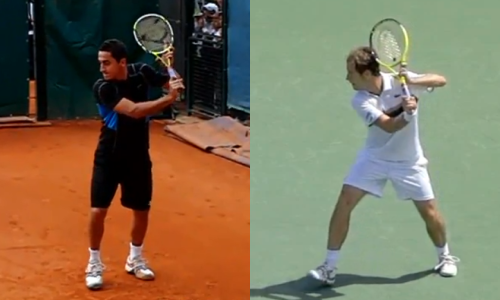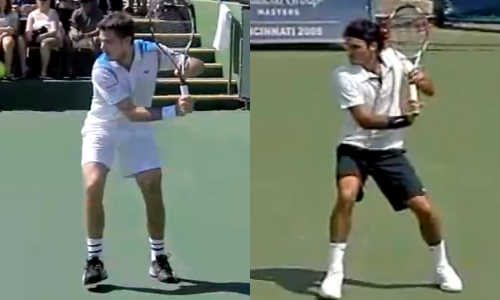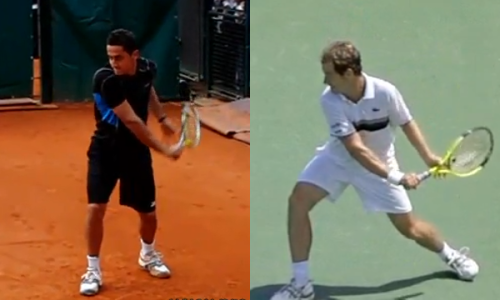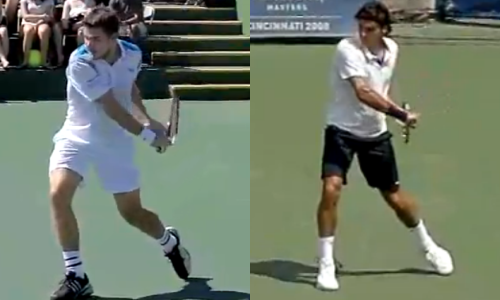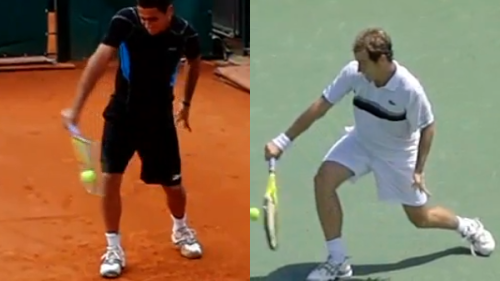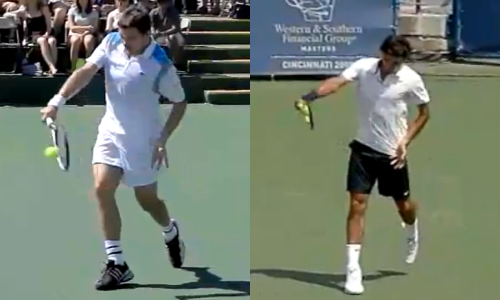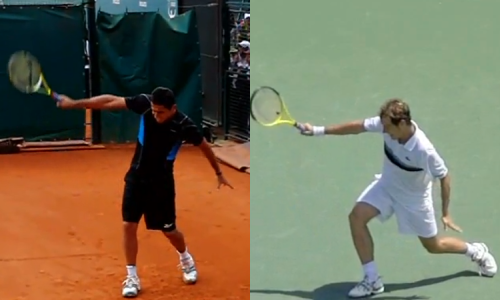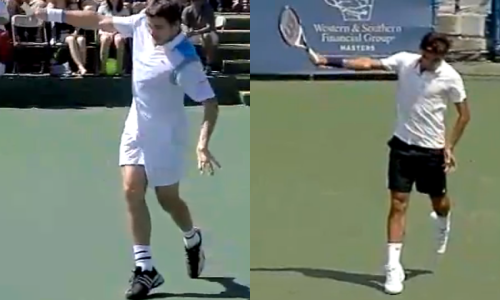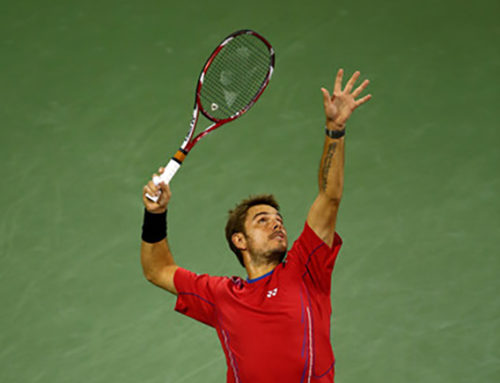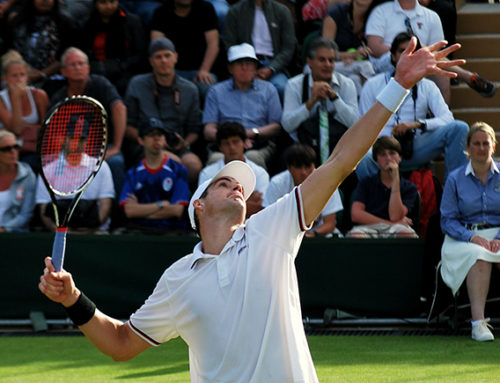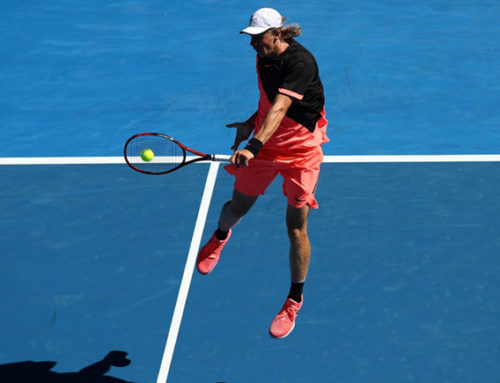Today we’re going to look at one-handed backhands. Specifically, the best four one-handed backhands in the world – those of Federer, Gasquet, Wawrinka and Almagro. Tommy Haas fans don’t despair – he certainly belongs in the conversation but as of the time of writing these four gentlemen are the highest ranked players with one-handed backhands and certainly all four have beautiful strokes in their own right. Purists of the game certainly decry the lack of one-handed backhands in tennis today, but let’s not plan funeral services just yet. With three of the top ten players in the world sporting one-handers rumors of its demise are greatly exaggerated! The point of today’s article is really two-fold: 1) to give people a better understanding of the key positions in a classic one-handed backhand and 2) to hopefully point out the subtle differences in the stroke of these four players so we can understand why they have different outcomes on the court. So without further ado, let’s dive right in.
Overview
Before we get too much into the technical aspects of the stroke, let’s establish a couple of ideas regarding the four backhands we will examine. Each of these four have a reputation that differs slightly from the others and covers a spectrum. Almagro hits a comparatively flat, extremely powerful driving ball with little variation. Wawrinka’s one-hander is slightly heavier, and more steady than Almagro’s. Federer generally hits a heavier spin ball with less pace than Almagro or Wawrinka, and his backhand is also more prone to go ‘off the rails’. Then there is Gasquet, who has probably the highest ‘top end’ of the four with the ability to hit pretty much everything with it – he can drive the ball with great pace, he can hit incredible spin for a one-hander, and everything in-between. So let’s take a look at the strokes and see what makes them tick. Note that there are subtle differences in each of the four shots these photos are taken from – we couldn’t exactly get Gasquet, Federer, Almagro and Wawrinka out on court with the ball machine for an hour to get photos of them hitting identical shots off the same ball. So bear that in mind as we look at the images.
The Chamber
The preparation phase of any stroke is, as the name suggests, the setup period. This is where the player puts the pieces in place for the kinetic chain that will soon be initiated. The preparation phase finishes in what I like to call the ‘chamber’ – where everything is prepared and ready to fire.
A couple of things to notice quickly here about the differences in their chamber positions. First of all, Gasquet has a more exaggerated wrist position – his wrist is rotated further up towards his forearm than Almagro’s. This opens the racket face up more, and together with the increased tilt in the racket head will provide for a more whip-like motion through the backswing generating more spin. Gasquet and Almagro both have relatively high hand positions in this frame.
It is a little uncanny just how identical Wawrinka and Federer’s positions are at this point in the swing. Note the relatively upright racket position standing almost perpendicular to the ground. Both Federer and Wawrinka’s rackets are more upright at this stage, whereas Gasquet and Almagro have laid the racket head back slightly. The two Swiss men also hold their forearms essentially parallel to the ground, with the right hand slung lower than Almagro and Gasquet. All four players have a good positive shoulder turn, have the left hand holding the throat of the racket for more positive racket control, and are looking to hit from a neutral or slightly closed stance.
The Bottom
From the chamber position the one-handed backhand will feature a dropping of the racket head as a part of the acceleration towards contact. This dropping of the racket head is critical for generating the topspin needed to hit the ball with real velocity and keep it in play.
Here we can see both players have extended their arm to either straight (Almagro) or a micro-bend (Gasquet) as they dropped the racket head down. Notice the upright position of the torso for both players, even though Gasquet is lunging for his shot in a wider hitting stance. Almagro releases the frame with the left hand a little earlier than Gasquet, but this shouldn’t have any real impact on the outcome of the swing.
In this frame we can see Federer start to differ from the others slightly. First, note the greater bend in the arm compared to Wawrinka. Secondly we can see that Federer has drawn the racket further around his body rotationally, with the string-bed essentially pointing to the back of the court. In comparison Wawrinka and Almagro have angled theirs back a moderate amount while Gasquet has angled his only slightly. This means that Federer will ‘uncoil’ through his swing more than the others – his backhand will swing out from his body with more of an arc compared with a more linear swing from the other three. This greater swing curvature does complicate the timing slightly. Add in the increased bend in the arm (something which we notice will disappear later in the swing) and we begin to see why Federer’s backhand is generally less steady in many respects (Almagro’s poor decision-making notwithstanding). His mechanics require more precise timing than the other three, and hence he is apt to mis-hit more balls than them. The final thing to note is how the hips for all four players have essentially not moved from the previous stage in the chamber position.
The Contact Point
What might leap out at you first from this image is just how far in front of the body Gasquet is making contact with the ball. The second thing you might note is just how extreme his grip is compared to Almagro. He is almost past an eastern backhand grip, with the first knuckle of his index finger approaching the back-diagonal bevel of his grip. This grip is part of the reason why Gasquet is able to attack the high ball so well off his backhand side (something he does better than the other three). However it also forces his hips into a slightly more open position at contact, something we can see in the picture also. Speaking of hips, Almagro’s have opened slightly from the chamber and dropped positions.
In the previous frame we had pointed out the greater bend in Federer’s arm compared to the other three. Now at contact we can see that his arm, like all the others’, is straight. Federer also is making contact very far out in front of the body, although this is partly due to the fact that the ball he is hitting is higher than that of Wawrinka’s. It is surprising to see just how much Wawrinka has opened up in this frame – although we expect some opening of the hips to allow the arm to come through and the shoulders to clear, Wawrinka’s position is slightly exaggerated compared to the others. One common theme to note is the position of the left hand – all four player release their left hand from the racket throat close to their own left hip – a position their hand now stays in until after contact. This is to help anchor the shoulders in position and prevent opening up too much too early.
Much is often made by commentators about the way that Federer seemingly tracks the ball until it makes contact with the strings. Meanwhile scientists claim that the moment of impact happens so quickly that it cannot be captured by the naked eye. What the image above seems to suggest however is that Federer truly isn’t seeing the contact itself in the way that people think. What is critical is the stability of the head during the contact phase. Most players will lift their head to track the ball off the strings but Federer’s gaze lingers considerably longer. This keeps his head locked in place, a positive thing for any budding tennis players to copy.
Follow-Through
The arm positions of both players here are remarkably similar. The critical difference to notice again is the increased openness of Gasquet’s hips – again likely due to the more extreme grip he uses. In contrast Almagro has actually moved his left hand backwards slightly, which helps to keep the shoulders from opening too much too quickly.
It is a shame that the video for Wawrinka cut off his racket here, but we can see he has a slightly more open position compared to Federer or Almagro. Both players have straight arms, and whereas Wawrinka has begun to raise his gaze and hence his head, Federer’s vision is still locked in on the same space it was a moment before. Notice how Federer’s left leg is kicked backwards, somewhat similar to that of a bowler (ten pin) after releasing the ball. This is designed to serve as a counter-weight to the arm and racket rotating in the opposite direction and helps anchor the hips in place to stop them from opening.
Five Points To Take Away
1) Get the racket up during your backswing. All four players hit an almost identical chamber position.
2) Locking the arm out earlier is a good thing. We can see Federer is late to straight his out and it simply adds one more complication to the timing of the stroke. It also creates a slightly less consistent stroke path compared to the other three.
3) Keep the hips closed until right before contact, and only open them a little. Players can use a countering motion with their left hand and left foot to help keep hips and shoulders closed.
4) Get the ball out in front. The higher the ball is, the further in front you need to catch it.
5) The differences are small. While we don’t know what shot each player hit off the images in question (heavy topspin vs flat, passing shot vs lob etc etc) we can say with certainty that the differences between all four backhands are subtle. Picking them out in real-time with the naked eye becomes extremely difficult if not impossible.
To be honest before starting this article I expected greater visual differences between the four of them. It’s clear that most of the differences in their hitting styles are more a matter of choice than technical limitation. Gasquet’s grip and consequent opening of the hips and shoulders at contact is the most significant difference between them all. Almagro and Wawrinka probably hit harder and flatter, not because they can’t hit more topspin, but because neither moves as well as Federer and hence must keep the initiative off that side. Federer prefers a heavier, more rolling ball because it buys him time to run around his backhand and hit forehands. Gasquet can do it all because he is a phenomenally talented ball striker with a technically fantastic backhand. We can see a couple of the small technical flaws that make Federer’s backhand more susceptible to error than the other three. Although Almagro might make more mistakes off that wing at times, his are less likely to be mishits and are rather just missed targets resulting from a significantly more aggressive attitude off that side than Federer is wont to swow.
